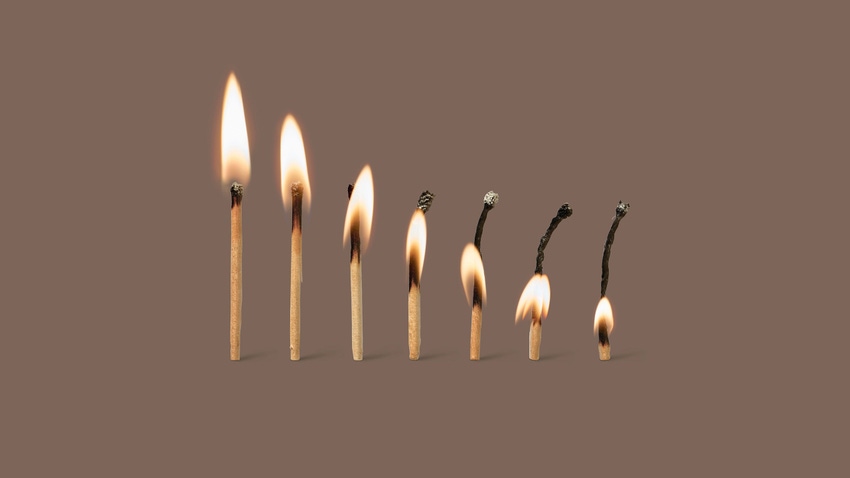
Read More from GDC 2024 | Keep up with the latest game industry event coverage from GDC 2024, including news, talks, interviews, and more from the Game Developer team.
What the game industry must do to prevent occupational burnout
Game industry working conditions are improving, but occupational burnout still runs amok. Studios and workers have the power to slow it down.

At a Glance
- Game writer Lis Moberly and designer Tim Stobo broke down research into game industry burnout at GDC 2024.
- Their data indicated developers may be crunching less, but are still being devastated by occupational burnout.
- The causes of burnout can be mitigated by actions from studios.
Occupational burnout is no joke.
Like with crunch—a word generally used to describe excessive overtime to meet project deadlines—the idea of game developers suffering in their workplaces while making video games is sometimes scoffed at by those unaffected by the phenomenon. After all, shouldn't you be grateful you get to make games instead of slinging burgers at McDonald's?
Setting aside how that mentality devalues both highly skilled game developers and the fast-food workers who keep the world fed—most of our readers are likely familiar with the pain and suffering that come with poor working conditions.
The worst symptoms may include memory loss and a reduction in the capacity to process cognitive activity, both symptoms of extreme stress. Developers may also see their moods sour and become angrier with their coworkers, or even find themselves in hospital.
These symptoms were among the many data points relayed by game designer Tim Stobo and game writer Lis Moberly in their presentation at the 2024 Game Developers Conference.
Stobo and Moberly described themselves as victims of burnout, and expressed a desire to build on previous discussions on the topic at past GDC events. Moberly told Game Developer in a quick post-presentation chat that she really wants developers to use their insight to "have a conversation" about burnout before it's clear that the problem is rampant.
"Often times we are trying to heal the disease after it's become cancerous. There needs to be prevention there."
Armed with survey data, academic citations, and a fiery determination to help their game industry peers, the pair forcefully made the case that burnout is not an inevitable phenomenon—and that studio leaders are among those with the power to protect their employees' mental health and well-being.
What drives burnout among game industry professionals?
First, how do you even quantify burnout? Stobo and Moberly relied on a definition authored by Drs. Christina Maslach and Michael P. Leiter. Maslach and Leiter identify burnout as a symptom of six "mismatches" between employees and their employers: work overload, lack of control, insufficient rewards, breakdown in community, an absence of fairness, and value conflicts.
In a sense, "mismatches" are like having a disability: it is not wrong or bad to have a disability, but those that do often experience a fundamental disconnect between the immediate environment and their physical needs.
Similarly, these six mismatches are not a criticism of an employee, nor do they indicate anything is bad or wrong with them. Rather, the language neutrally reflects the relationship they have with their work environment.
Image via Game Developers Conference
Though employers bear the high-level responsibility of preventing burnout, Stobo and Moberly pointed out that workers may experience these mismatches not through conflict with the company but as an issue arising among colleagues.
If employees are experiencing these mismatches, and then feel lowered energy, a declining level of interest in their work, or reduced efficacy, then they are likely experiencing occupational burnout.
Who suffers the most from burnout?
Burnout can strike developers at all experience levels, but Moberly and Stobo found some fascinating data from an online survey they conducted by reaching out to fellow industry professionals.
According to respondents, developers with four-to-six years of experience were most likely to report burnout, a datapoint that correlates to a similar stat when scanning responses by job title: developers who classified themselves as "senior" developers were the most likely to say they had experienced burnout.
Image via Game Developers Conference.
Now, here's the rub: according to the data, the burnout trend did not directly increase in correlation with time in the industry or seniority of role. Lead developers and developers with over six years of experience in the game industry were slightly less likely to report that they had experienced burnout.
Game directors were very unlikely to report burnout, only making up 13 percent of those who reported it.
The pair's theory is that at the senior level, developers begin to feel more confident in their roles but then run into barriers in securing increased rewards or retaining the desired amount of control over their work.
Another fact worth mentioning: principal developers were surprisingly less likely to say they'd experienced burnout. Stobo commented that in his experience, principal developers are often treated the same as leads, so it may be possible that the responsibility of team management is a big driver of burnout in higher-level roles.
When all is said and done, all demographics are at risk of burnout, but structural factors—including the marginalization sometimes experienced by workers from underrepresented races, genders, sexualities, as well as workers with disabilities or who are neurodivergent—create scenarios where some professionals will be at greater risk of burnout than others.
How do developers recover from burnout?
Thankfully, "the majority" of developers reported they have recovered from burnout, but 30 percent told Moberly and Stobo they were living through it at the time of submitting their responses.
Recovery times from burnout ranged anywhere from less than a month to three or more years. About 27 percent bounced back between zero and six months, and another 20 percent pulled it off between six months to a year.
But almost 30 percent said it took them one to three years to recover. About 11 percent needed three to five years. And just over 13 percent said they needed five or more years to come back from the brink.
Moberly said only about half of respondents had taken sufficient time off to recover, with the majority reporting taking between two weeks to three months off of work. "That's really alarming," she said. "Recovery can take up to three years, but many can't take time off at all."
"Those who do take time are not taking enough so they're staying in the workplace or re-entering a new studio still completely burned out."
What should employers do to prevent burnout?
Like a fire raging through the hills of Southern California and Stobo's region of Australia, burnout is a fire that spreads through dry kindling.
Over 85 percent of respondents indicated they knew other employees at their companies had expressed feelings of burnout. If you're a studio leader and you have one employee who says they're burned out, they're likely a canary in your game development coal mine.
Not only did most developers indicate their employer offered zero training or resources to cope with burnout, some said their employers outright denied it. Resources that companies did offer were often deemed counterproductive. Moberly shared one comment from a respondent saying their corporate wellness sessions were "patronizing or useless at best" and "harmful at worst."
Studios may be reluctant to discuss the topic because of legal liability or because of the tunnel vision that comes with driving a project to the finish line. "The truth is, they're only hurting their projects when they don't address it," she said in our follow-up conversation.
Moberly said that her and Stobo's research, combined with findings from professionals like Maslach and Leiter, was a good start but that more research needs to be done to create a "shared language" about burnout so developers and employers can properly communicate its impact to each other.
Studios can run anonymous surveys or "burnout inventories" of their own using processes developed by the aforementioned PhDs, but they should be run in collaboration or conjunction with an employee representative so that the definitions of burnout can be properly identified.
The keyword here is "anonymous." Employees "need an opportunity to be candid and share with their leadership what they are experiencing, without any limits," said Moberly.
Stobo cautioned that one survey pass and limited changes won't fix the problem in one go. Regular check-ins and achievable goals can begin to relieve pressure, but every workplace will need custom solutions and multi-step processes.
Moberly meanwhile urged workers to arm themselves with information about their rights and resources (such as overtime, breaks, and time off) and to "lean into their communities," not just their companies, for support.
Battling the "three myths" of burnout—that it's an individual problem, that "crunch" is the only problem in need of solving, and that "cynicism and toxicity" are the core problems that must be purged—is a necessary task for employers and employees alike.
That last myth addressed the fact that many employers will try to just focus on maintaining good vibes rather than investigating possible problems. Moberly said one developer reported being dressed down by leadership and told that their frustration was "pissing off" the entire team, that everyone hated them, and that they should consider their future at the company.
The fact that any studio is willing to tell a worker that the rest of their team hates them is a signifier that companies alone will not be the ones who fix burnout.
But they can absolutely be part of—and benefit from—the solutions.
There is life after the raging fire
Moberly made reference to her and Stobo's home regions and the wildfires they experience for a specific reason. In each area, wildfires are part of an environmental cycle that refreshes the soil and leaves flowers like the Fire Poppy blooming in their wake.
These fires (exacerbated by a worsening industrial-driven climate crisis) can be devastating in their impact. Moberly invoked them not to treat the fires as inevitable or to say burnout is part of a natural cycle, but to describe the beauty and regrowth that can take place in their wake.

Image by Sundry Photography via Adobe Stock.
It's a natural instinct to look at Stobo and Moberly's survey and feel a deep anger at the forces that have harmed so many talented and creative workers. Gleeful CEOs, celebrity game designers, and weary industry veterans have all made the case that conditions fueling burnout are a part of the game development life cycle.
But peer closer at their words, and you will hopefully let that rage pass like a fleeting shadow.
A brighter future for the game development community will be born not just from worker-led resistance, but from mutual care and dedication to the idea that a better world is possible.
Game Developer and Game Developers Conference are sibling organizations under Informa Tech.
About the Author(s)
You May Also Like









